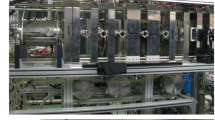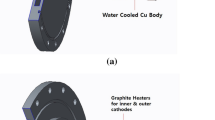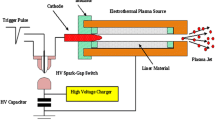Abstract
Simulation studies of core plasmas and edge plasmas are performed in ASIPP to accommodate plasma profiles from core to edge based on physics modeling for the CFETR physics design. The coupling between the modeling for core plasmas and edge plasmas are described. The recent progress of the integrated core-pedestal simulations for core plasmas and the SOLPS simulations for plasmas in pedestal-SOL-divertor region are presented, respectively. In the optimization study for core plasma performance, moderate Z eff (~ 2.2) at pedestal top and a high ratio of density at separatrix to density at pedestal (n sep /n ped ~ 0.5) are found to be beneficial for the achievement of a high fusion gain in CFETR hybrid scenarios. The edge plasma simulations using the SOLPS code show that using either neon or argon impurity seeding can reduce the stationary power density on the divertor target to an acceptable level (< 10 MW/m2) but Z eff at pedestal top is still high (Z eff ~ 3). Future works to improve the consistence between the simulations of core and edge plasmas are discussed.













Similar content being viewed by others
References
J. Candy et al., Phys. Plasmas 16(6), 060704 (2009)
J. Citrin et al., Plasma Phys. Controlled Fusion 59(12), 124005 (2017)
A.R. Polevoi et al., Nucl. Fusion 55(6), 063019 (2015)
A.R. Polevoi et al., Nucl. Fusion 57(2), 022014 (2017)
A.R. Polevoi et al., Nucl. Fusion 58(5), 056020 (2018)
A.Y. Dnestrovskiy et al., Nucl. Fusion 59(9), 096053 (2019)
L. Garzotti et al., Nucl. Fusion 59(2), 026006 (2019)
B. Wan et al., IEEE Trans. Plasma Sci. 42(3), 495–502 (2014)
Y.T. Song et al., IEEE Trans. Plasma Sci. 42(3), 503–509 (2014)
V.S. Chan et al., Nucl. Fusion 55(2), 023017 (2015)
Y. Wan et al., Nucl. Fusion 57(10), 102009 (2017)
G. Zhuang et al., Nucl. Fusion 59(11), 112010 (2019)
J.E. Kinsey et al., Nucl. Fusion 43(12), 1845–1854 (2003)
X. Litaudon et al., Nucl. Fusion 53(7), 073024 (2013)
G.Z. Jia et al., Phys. Plasmas 27(6), 062509 (2020)
O. Meneghini et al., Phys. Plasmas 23(4), 042507 (2016)
O. Meneghini et al., Nucl. Fusion 55(8), 083008 (2015)
G.M. Staebler et al., Phys. Plasmas 12(10), 102508 (2005)
G.M. Staebler et al., Phys. Plasmas 14(5), 055909 (2007)
E.A. Belli, J. Candy, Plasma Phys. Controlled Fusion 50(9), 095010 (2008)
E. Belli, J. Candy, Plasma Phys. Controlled Fusion 51(7), 075018 (2009)
G.M. Staebler, Nucl. Fusion 58(11), 115001 (2018)
W.A. Houlberg et al., Nucl. Fusion 45(11), 1309–1320 (2005)
C.E. Kessel et al., Nucl. Fusion 47(9), 1274–1284 (2007)
R. Budny et al., Nucl. Fusion 48(7), 075005 (2008)
A.H. Kritz et al., Nucl. Fusion 51(12), 123009 (2011)
M. Murakami et al., Nucl. Fusion 51(10), 103006 (2011)
A. Pankin et al., Comput. Phys. Commun. 159(3), 157–184 (2004)
Y.R. Lin-Liu et al., Phys. Plasmas 10(10), 4064–4071 (2003)
Smirnov A. and Harvey R. 2001 CompX Report CompX-2000–01.
Pfeiffer W.W. et al. ONETWO: a computer code for modeling plasa transport in tokamaks. ; General Atomic Co., San Diego, CA (USA); 1980. Report No.: GA-A-16178; TRN: 81–006489 United States TRN: 81–006489 NTIS, PC A10/MF A01. GA English.
P.B. Snyder et al., Phys. Plasmas 16(5), 056118 (2009)
P.B. Snyder et al., Nucl. Fusion 51(10), 103016 (2011)
J. Chen et al., Nuclear Fusion (accepted) (2021). https://doi.org/10.1088/741-4326/abd7b8
M. Wakatani et al., Nucl. Fusion 39(12), 2175–2249 (1999)
B. Li et al., Fusion Eng. Des. 148, 111295 (2019)
C.X. Zhou et al., Nucl. Fusion 60(9), 096029 (2020)
M. Greenwald, Plasma Phys. Controlled Fusion 44(8), R27–R80 (2002)
Chen J. et al. 2019 23rd TOPICAL CONFERENCE ON RADIOFREQUENCY POWER IN PLASMAS. p. I3.4.
J. Huang et al., Plasma Phys. Controlled Fusion 62(1), 014019 (2020)
J. Huang et al., Nucl. Fusion 60(12), 126007 (2020)
R.A. Pitts et al., Nuclear Materials and Energy 20, 100696 (2019)
X.J. Liu et al., Phys. Plasmas 27(9), 092508 (2020)
Bonnin X. et al 2016 Plasma and Fusion Research. 11 1403102
I.Y. Senichenkov et al., Plasma Phys. Controlled Fusion 61(4), 045013 (2019)
E. Sytova et al., Nuclear Materials and Energy 19, 72–78 (2019)
E. Kaveeva et al., Nucl. Fusion 60(4), 046019 (2020)
P.C. Stangeby, Plasma Phys. Controlled Fusion 43(2), 223 (2000)
Acknowledgement
This work is supported by the National Magnetic Confinement Fusion Program of China under Contracts No. 2017YFE0300500 and No. 2017YFE0300501. The authors acknowledge fruitful cooperation in the CFETR physics team and especially Prof. Vincent. S. Chan for his introduction of schemes to simulate a whole plasma in tokamaks. We appreciate the theory and computational sciences group in General Atomic for their valuable supports in the use of the GA code suites. Numerical computations were performed on the ShenMa High Performance Computing Cluster in Institute of Plasma Physics, Chinese Academy of Sciences.
Author information
Authors and Affiliations
Corresponding author
Additional information
Publisher's Note
Springer Nature remains neutral with regard to jurisdictional claims in published maps and institutional affiliations.
Rights and permissions
About this article
Cite this article
Chen, J., Jia, G. & Xiang, N. Recent Progress in Modeling of CFETR Plasma Profiles from Core to Edge. J Fusion Energ 40, 1 (2021). https://doi.org/10.1007/s10894-021-00292-7
Accepted:
Published:
DOI: https://doi.org/10.1007/s10894-021-00292-7




